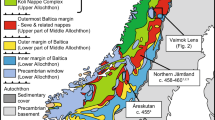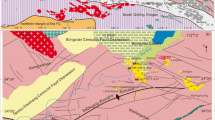Abstract
We discovered the oldest rock in South Korea, and dated this migmatite using a Sensitive High-Resolution Ion Micro-probe (SHRIMP). Zircon grains from a tonalitic migmatite, Daeijak Island, western Gyeonggi massif, are distinctly zoned and commonly characterized by oscillatory-zoned cores and structureless rims. The U-Pb zircon ages estimated from six spot analyses of the rims in five grains define a concordant age group with the weighted mean 207Pb/206Pb age of 2508 ± 18 Ma, interpreted as the age of migmatization. On the other hand, the cores yield an older 207Pb/206Pb age of ca. 2.58 Ga, interpreted as the crystallization age of tonalitic protolith. These results demonstrate not only the presence of Neoarchean granitoids but also high-grade migmatitic metamorphism at ca. 2.51 Ga in the Gyeonggi massif, which are correlative with those reported from the North China craton.
Similar content being viewed by others
References
Cho, D.-L., 2004, Mineral separation and sample preparation methods efficient for subgrain zircon analyses. Journal of Petrological Society of Korea, 13, 126–132. (in Korean with English abstract)
Cho, D.-L., Kim, Y.-J., and Amstrong, R., 2006, SHRIMP U-Pb geochronology of detrital zircons from iron-bearing quartzite of the Seosan Group: Constraints on age and stratigraphy. Journal of Petrological Society of Korea, 15, 119–127. (in Korean with English abstract)
Cho, M., 2001, A continuation of Chinese ultrahigh-pressure belt in Korea: evidence from ion microprobe U-Pb zircon ages. Gondwana Research, 4, 708.
Cho, M., 2003, Triassic high-pressure metamorphism in western Gyeonggi massif, Korea: correlation with the Dabie-Sulu belt in China. Alice Wain Mem. (Abstract), West. Norw. Eclog. Field Symp., p. 36.
Cho, M., Kim, Y., and Ahn, J., 2007, Metamorphic evolution of the Imjingang belt, Korea: Implications for Permo-Triassic collisional orogeny, International Geology Review, 49, 30–51.
Chough, S.K., Kwon, S.-T., Ree, J.-H., and Choi, D.K., 2000, Tectonic and sedimentary evolution of the Korean peninsula: a review and new view. Earth-Science Reviews, 52, 175–232.
Faure, M., Lin, W., Monie, P., Le Breton, N., Poussineau, S., Panis, D., and Deloule, E., 2003, Exhumation tectonics of the ultrahigh-pressure metamorphic rocks in the Qinling orogen in east China: New petrological-structural-radiometric insights from the Shandong Peninsula. Tectonics, 22, 1019, doi:10.1029/2002TC001450.
Hou, G., Liu, Y., and Li, J., 2006, Evidence for ∼1.8 Ga extension of the Eastern Block of the North China Craton from SHRIMP U-Pb dating of mafic dyke swarms in Shandong Province. Journal of Asian Earth Sciences, 27, 392–421.
Ireland, T.R. and Williams, I.S., 2003, Considerations in zircon geochronology by SIMS. In: Hanchar, J.M. and Hoskin, P.W.O. (eds.), Zircon. MSA, Reviews in Mineralogy & Geochemistry, 53, p. 215–241.
Jeon, H., Cho, M., Kim, H., Horie, K., and Hidaka, H., 2007, Early Archean to Middle Jurassic evolution of the Korean Peninsula and its correlation with Chinese cratons: SHRIMP U-Pb zircon age constraints. Journal of Geology, 115, 525–539.
Kim, J.N., Ree, J.-H., Kwon, S.-T., Park, Y., Choi, S.J., and Cheong, C.-S., 2000, The Kyonggi shear zone of the central Korean peninsula: late orogenic imprint of the North and South China collision. Journal of Geology, 108, 469–478.
Kim, O.J., 1973, The stratigraphy and geologic structure of the metamorphic complex in the northwestern area of the Kyonggi Massif. Journal of Korean Institute of Mining Geology, 6, 201–218. (in Korean with English abstract)
Kröner, A., Wilde, S.A., Li, J.H., and Wang, K.Y., 2005, Age and evolution of a Late Archaean to early Palaeozoic upper to lower crustal section in the Wutaishan/ Hengshan/Fuping terrain of northern China. Journal of Asian Earth Sciences, 24, 577–595, doi: 10.1016/j.jseaes.2004.01.001.
Lee, D.S., 1987 (ed.), Geology of Korea. Geological Society of Korea, Kyohak-Sa, Seoul, 514 p.
Lee, S.R. and Cho, M., 1995, Tectonometamorphic evolution of the Chuncheon amphibolite, central Gyeonggi massif, South Korea. Journal of Metamorphic Geology. 13, 315–328.
Lee, S.R. and Cho, M., 2003, Metamorphic and tectonic evolution of the Hwacheon granulite complex, central Korea. Journal of Petrology, 44, 197–225.
Lee, S.R., Cho, M., Yi, K.-W., and Stern, R., 2000, Early Proterozoic granulites in central Korea: Tectonic correlation with Chinese cratons. Journal of Geology, 108, 729–738.
Lee, S.R., Cho, M., Cheong, C.S., Kim, H., and Wingate, M.D., 2003, Age, geochemistry, and tectonic significance of Neoproterozoic alkaline granitoids in the northwestern margin of the Gyeonggi massif, South Korea. Precambrian Research, 122, 297–310.
Lee, S.R., Cho, D.-L., Cho, M., Wu, F.-Y., Kim, H., and Jeon, H., 2007, Hf isotopic evidence for Paleoarchean (> 3.5 Ga) crustal components in the Korean Peninsula. Geosciences Journal, 11, 271–278.
Lee, Y. and Cho, M., 2006, Partial melting origin of Neoarchean migmatites in Daeijak Island, South Korea: A preliminary study. Goldschmidt Conference, Melbourne, Abstract volume, A11.
Ludwig, K.R., 2001, User’s manual for SQUID 1.02. Berkeley, CA, Berkeley Geochronology Center Special Publication, No. 2, 17 p.
Ludwig, K.R., 2003, User’s manual for Isoplot 3.00: a geochronological toolkit for Microsoft Excel. Berkeley, CA, Berkeley Geochronology Center Special Publication, No. 4, 47 p.
Oh, C.W., Kim, S.W., Choi, S.G., Zhai, M., Guo, J., and Sajeev, K., 2005, First finding of Eclogite Facies metamorphic event in South Korea and its correlation with the Dabie-Sulu Collision Belt in China. Journal of Geology, 113, 226–232.
Oh, C.W., Kim, S.W., and Williams, I.S., 2006, Late Permian HT spinel granulite in Korea and its tectonic implications for the collision between the North and South China Blocks. Lithos, 92, 557–575.
Paces, J.B. and Miller Jr., J.D., 1993, Precise U-Pb ages of Duluth Complex and related mafic intrusions, northeastern Minnesota: new insights for physical, petrogenetic, paleomagnetic, and tectono-magmatic processes associated with 1.1 Ga Midcontinent rifting. Journal of Geophysical Research, 98, 13997–14013.
Paek, R.J., Kang, H.G., and Jon, G.P., 1996, Geology of Korea. Foreign Languages Books Publishing House, Pyongyang, Korea, 631 p.
Rubatto, D., 2002, Zircon trace element geochemistry: distribution coefficients and the link between U-Pb ages and metamorphism. Chemical Geology, 184, 123–138.
Sakashima, T., Terada, K., Takeshita, T., and Sano, Y., 2003, Largescale displacement along Median Tectonic Line, Japan: evidence from SHRIMP U-Pb dating of granites and gneisses from South Kitakami and paleo-Ryoke belts. Journal of Asian Earth Science, 21, 1019–1039.
Stacey, J.S. and Kramers, J.D., 1975, Approximation of terrestrial lead isotope evolution by a two-stage model. Earth and Planetary Science Letters, 26, 207–221.
Wilde, S.A., Cawood, P.A., Wang, K.Y., and Nemchin, A.A., 2005, Granitoid evolution in the late Archean Wutai Complex: North China Craton. Journal of Asian Earth Sciences, 24, 597–613, doi: 10.1016/j.jseaes.2003.11.006.
Wu, F.-Y., Han, R.-H., Yang, J.-H., Wilde, S.A., Zhai, M.-G., and Park, S.-C., 2007, Initial constraints on the timing of granitic magmatism in North Korea using U-Pb zircon geochronology. Chemical Geology, 238, 232–248.
Zhao, G. and Kröner, A., 2007, Geochemistry of Neoarchean (ca. 2.55–2.50 Ga) volcanic and ophiolitic rocks in the Wutaishan greenstone belt, central orogenic belt, North China craton: implications for geodynamic setting and continental growth: Discussion. Geological Society of America Bulletin, 119, 487–489; doi: 10.1130/B26022.1.
Zhao, G.C., Sun, M., Wilde, S.A., and Li, S.Z., 2005, Late Archean to Paleoproterozoic evolution of the North China Craton: key issues revisited. Precambrian Research, 136, 177–202, doi: 10.1016/j.precamres.2004.10.002.
Zhao, G.C., Cao, L., Wilde, S.A., Sun, M., Choe, W.J., and Li, S., 2006, Implications based on the first SHRIMP U-Pb zircon dating on Precambrian granitoid rocks in North Korea. Earth and Planetary Science Letters, 251, 365–379; doi: 10.1016/j.epsl.2006.09.021.
Author information
Authors and Affiliations
Corresponding author
Rights and permissions
About this article
Cite this article
Cho, M., Kim, H., Lee, Y. et al. The oldest (ca. 2.51 Ga) rock in South Korea: U-Pb zircon age of a tonalitic migmatite, Daeijak Island, western Gyeonggi massif. Geosci J 12, 1–6 (2008). https://doi.org/10.1007/s12303-008-0001-1
Received:
Accepted:
Published:
Issue Date:
DOI: https://doi.org/10.1007/s12303-008-0001-1




